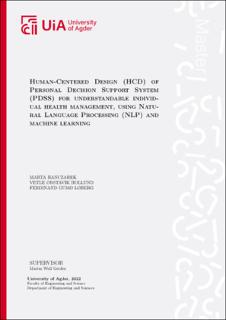| dc.description.abstract | This project addressed the challenges of patients to comprehend typical information (e.g. in the form of ''doctor letters'' or ''patient journals'') about their health condition, and to get understandable and personalized recommendations in a user friendly way to improve their health and well-being, considering their individual and actual health status. The chosen approach has been to explore the possibilities of natural language processing technologies and use of machine learning (particularly random forests), integrated in a Human-Centered Design of a personal decision support system. The project followed a combination of Design Science Research Methodology and Human-Centered Design Methodology. For the initial user needs assessment, 12 interviews with potential users of the target application were carried out, representing varying degrees of experience with the Norwegian health care system. The interviews showed a large gap in the comprehension of the information contained in personal medical journals, and resulted in the problem specification, needs assessment, and a PACT analysis. Further a series of requirements were produced with the use of Volere shells.
The project was divided into three main parts, Natural Language Processing (for the data extraction and content summarization), personal health suggestions (with use of machine learning and feature importance determination), and front end design (for an integrated target application).
The language processing was largely based on pre-trained transformer based models tuned for downstream tasks. Several models trained with biomedical and clinical text were evaluated on automated summarization, semantic search and assertion detection, and showed promising results. Areas of improvement and future work were summarization of short texts and formal evaluation of medical term explanations.
The front end design went trough three iterations, a low fidelity prototype in the for of a paper prototype, and two versions of the high fidelity prototype. The user testing showed an improvement in understanding of medical data in both high fidelity prototypes.
The health suggestion were based on the feature importance determination of random forests. Three different determination methods were tested, finding minor variations in results, but with Gini Importance gaining a major advantage in computational speed. The recommendation produced could not be tied to clinical results but would require further study to prove or disprove the effectiveness of the recommendations. | |
